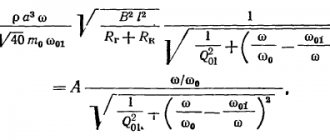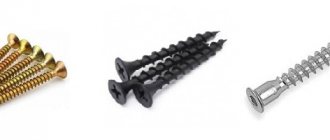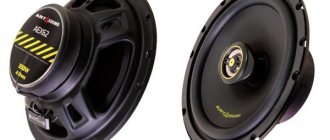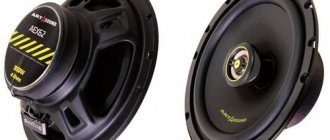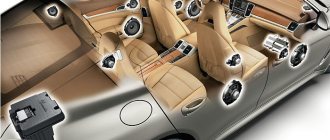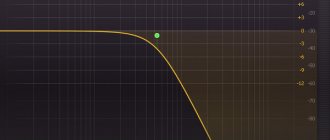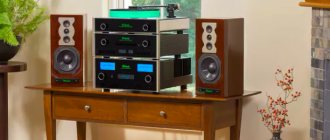FI or Bass reflex
Pros:
- High efficiency (louder than ZY)
- Good cooling of the subwoofer coil
- The ability to customize the design for certain genres of music in order to obtain maximum efficiency in a certain low-frequency band
Minuses:
- Calculation complexity
- Takes up much more space than ZYa
- It has a more diffuse bass, unlike ZY (by the way, the quality of bass in FI can still be improved, but by sacrificing pressure)
Subwoofer box. Closed, bass reflex, bandpass
Which design is better for a subwoofer?
Introduction
The acoustic box for a subwoofer is the most important component for an audio system. Many beginners do not know which option for a subwoofer to choose, since there are many acoustic designs for a subwoofer in car audio. The most popular types of subwoofer boxes are a closed box (CL) and a bass reflex box (FI).
There are also other designs - 4th and 6th order bandpass (BP), quarter-wave resonator (QW), Free-air. These are more complex options and are used less frequently.
Closed box (CL)
The simplest type of design. Simple calculation and easy assembly of the structure. An excellent option for fans of rock, club, jazz. Suitable for those who need space in the trunk, but want bass.
Pros of ZY:
- Simple calculation and assembly.
- Small volume and compact dimensions.
- Structured, fast bass, without lag.
- Option for SQ systems.
Disadvantages of ZY:
- Low level of efficiency (decisive factor).
- Poor voice coil cooling.
Bass reflex (FI)
The most common type of design. A more complex calculation and assembly option compared to a closed box. An excellent option for club lovers, turnips (blacks). Suitable for those who don't mind trunk space. There are three types of box design: slotted, open pipe and expo.
Volume and area of the FI port
Pros of FI:
- High level of efficiency (much louder than ZYa).
- Simple calculation.
- Possibility of design to suit the style and genres of music (maximum efficiency at a certain frequency).
- Good voice coil cooling.
Cons of FI:
- Blurred, slow, delayed bass (bass quality can be improved).
- Large volume and size.
Exponential Port (EXPO)
A type of design that is gaining popularity. A type of bass reflex (PI), but in the middle the gap narrows and widens towards the edges.
Pros in relation to FI:
- High level of efficiency (louder than FI).
- Wide and flat sound shelf.
- More pleasant sound.
Disadvantages in relation to FI:
- Complex calculation.
- Difficult to manufacture due to the curved port.
Quarter-wave resonator (QW)
A simple waveguide, where the speaker pumps a wave, the waveguide conducts it, delaying it in time, thereby shifting the phase by 90 degrees. Roll-off below the tuning frequency is 6 dB per octave. With a setting of 38-40 Hz, the frequency response will also play below 30 Hz. At the tuning frequency, the impedance is maximum.
A very complex calculation option and huge sizes, due to which it is less popular compared to FI.
There are two types of box design: classic rolled-up CV and tapered rolled-up CV.
The difference between a tapering HF and a classic one is that the tunnel smoothly narrows from 3 woofer areas at the beginning to 1.5 at the output at the end.
The tapered frequency response is much more difficult to manufacture and larger in volume, but the result is impressive - the bass is uniquely fast, accurate and deep.
Pros of CV:
- The highest level of efficiency (louder than FI and bandpass).
- Low level of group delays, precision bass processing and detail.
- Smooth and wide frequency range.
Disadvantages of CV:
- A very complex calculation.
- Huge size (sometimes the trunk itself is missing).
- Demanding when choosing a subwoofer (the presence of a long-throw moving system, a powerful magnetic system with a low quality factor).
- Difficulty setting up the amplifier.
- It is contraindicated to use an amplifier that exceeds the RMS power of the subwoofer by 2 times or more.
Bandpass (BP)
A type of design whose body is divided into resonant chambers. One of the chambers houses a speaker, and the second a bass reflex. This type of design is capable of reproducing even the lowest frequencies with high quality. A very complex calculation option. You need good calculation skills and special programs.
PS Most often we are used to seeing this design when building a wall in a car. Bandpass comes in 4th and 6th order. The 6th order bandpass differs from the 4th order by the presence of another bass reflex on the inside of the subwoofer.
Pros of BP:
- Very high level of efficiency (louder than FI, quieter than CV).
- Excellent low frequency sound.
- There is no need to use a bandpass filter.
- Protecting the speaker from external influences.
Disadvantages of PSU:
- Very complex calculation (not for beginners).
- Complexity and labor intensity in manufacturing.
- Huge sizes.
- Narrow frequency range (not for wide-range woofer).
- Difficulty in replacing the subwoofer.
What can you say about the bass reflex?
The bass reflex in the subwoofer is distinguished by vague bass, which not everyone will like. On the other hand, if you need the bass to go “into the ground,” this kind of acoustic system is just perfect.
Another point is that the hole allows you to increase the frequency output, which seriously expands the sensitivity of the speaker system as a whole.
Generally speaking, the bass reflex and bass reflex systems are designed to make sounds louder and more atmospheric.
Operating principle
Motorists may be familiar with a resonator, another example of which is the CV box For example, it is used as a functional element of a muffler. In this case, the hollow structure has its own characteristics and another purpose.
From a technical point of view, a resonator is an oscillatory system that accumulates vibrations due to frequency resonance. Typically, the design involves “working” with a limited set of frequency characteristics. Depending on the design, resonators of cumulative and instantaneous action differ.
Homemade wooden box
The storage resonator accumulates external energy by reducing the frequency of internal oscillations. In a mathematical context, any resonator design whose oscillation frequency is greater than the oscillation frequency of the external influence is cumulative. This happens whether the diameter is 10 or 12 inches, but you need to choose a different volume.
Instantaneous action implies the correspondence of the internal oscillatory force in period to external oscillations. Such resonators increase the sound power due to thermal absorption of the surrounding space, shifting the frequency at the input power - changes due to an increase in the playback interval.
The common CV box has a rectangular shape with partitions resembling a caterpillar in arrangement. The appearance will depend on the speaker and its features, size – 10″ or 12 inches. At the moment, you can find drawing diagrams for any frequency device and make a resonator at no extra cost. It will differ slightly from the brand name.
You can make a resonator in a mini version. This solution is shown in the figure.
Drawing of a CV box for 12″
To obtain drawings of 10, 12 and 15″ HF boxes, you can use a search engine or our resonator database or calculation program. The easiest way is to search by type of speaker and required volume. For example, a 12″ CV box can be implemented in several versions, depending on the technical features described and demonstrated below.
What materials do we need to assemble the subwoofer?
Multilayer plywood for the subwoofer box The material for making the subwoofer box must be strong, dense and well insulating sound. Multilayer plywood or chipboard is perfect for this. The main advantages of these materials are their affordable price and ease of processing. They are quite durable and provide good sound insulation. We will make a subwoofer from 30 mm thick multilayer plywood.
To make a subwoofer box we will need:
Wood screws (approximately 50-55 mm, 100 pieces) Soundproofing material (Shumka) Drill and screwdriver (or screwdriver) Jigsaw Liquid nails Sealant PVA glue Carpet, approximately 3 meters Terminal block
Subwoofer box drawings
In this article we will make a box for a subwoofer with a 12-inch speaker. The recommended box volume for one 10-12 inch speaker is 40-50 liters. Calculating a box for a subwoofer is not difficult, here is an approximate diagram with the dimensions of the panels. Diagram and drawing of the box It is worth paying attention to the minimum distance from the walls of the case to the speaker. It, like the volume of the entire box, is calculated based on the inner surface.
Assembling a subwoofer box with your own hands
You can start assembling. We use a 12-inch Lanzar VW-124 speaker. 12-inch subwoofer speaker Its diameter is 30 cm, and the first thing you need to do is cut a hole for the speaker. The minimum distance from the center of the diffuser to the subwoofer wall is 20 cm. We measured 23 cm (20 cm + 3 cm plywood width) from the edge of the panel and cut a hole with a jigsaw. Next, we cut a hole for the bass reflex slot; in our example, it has a size of 35*5 cm.
Cut out the bass reflex slot and the hole for the speaker
Instead of a slot, you can use a classic air duct - a tube. Now we assemble the bass reflex slot and attach it to the front panel of the subwoofer. We go along the joints with liquid nails and tighten them with self-tapping screws. Assembling the bass reflex slot panels It is important to tighten the screws very tightly so as not to leave any voids. They will create resonant vibrations that will ruin the sound of the subwoofer.
Next, we assemble the side walls of the box, having previously lubricated them with liquid nails, and tighten them tightly with self-tapping screws. Side walls of the box On the back cover of the box you need to cut a small hole for the terminal block. We connect all parts of the body. We make sure that we cut and fastened all the parts correctly. Box assembly Insert the speaker. Let's look and admire.
Interior decoration
Let's move on to the interior decoration of the box. The first thing you need to do is seal all the joints and cracks with epoxy glue or sealant. Next, using PVA glue, we glue soundproofing material onto the entire inner surface of the box. We cover the body with Shumka. We cover the body with Shumka. Now we cover the entire outer plane of the box with carpet, including the bass reflex slot. You can attach it with epoxy glue or using a furniture stapler. The box is covered with carpet. Next, we insert and screw the speaker tightly. The subwoofer is almost ready, all that remains is to stretch the wires from the speaker to the terminal block and connect the amplifier. Installed subwoofer with amplifier We bought an additional amplifier, but you can also make it yourself. This is quite difficult, as it requires knowledge and practice in the field of radio engineering. You can also use ready-made kits and circuits for radio amateurs, like Master-KIT, and assemble the amplifier yourself. The only requirement for the amplifier is that its maximum power must be less than the maximum power of the speaker.
The main advantages and disadvantages of bass reflexes
The main advantages of bass reflex devices for subwoofers in vehicles include the following:
- Reducing the level and indicators of vibration and distortion of the diffuser.
- Higher quality, clearer and more pleasant sound for human perception. True, this does not apply to every genre and type of composition, but to certain types of music. Due to air currents flowing directly into the ventilation hole, the sound will resemble a small, barely audible whistle. This whistle is very similar to the one that is produced when a person blows on the neck of an empty bottle.
The main advantages of bass reflexes for subwoofers in cars include the following:
- The sounds produced by air ducts when playing a song may cause more harm than good, but this does not apply to all types of music, but only to some of them. As noted above, bass reflexes are that complex in the overall acoustic system of a vehicle that cannot be suitable for absolutely any music.
- A bass reflex is a fairly sensitive type of housing, and its sensitivity in particular extends to changes in climate. Most of all, the operation of the bass reflex depends on such climatic indicators as temperature indicators, as well as the level and percentage of humidity.
- The bass reflex and the type of housing, oddly enough, contribute to physical fatigue of a person.
- Due to the constant high pressure inside the bass reflex housing, the system must be very durable. All this suggests that it is more difficult to make and sell, and the cost is included in the final price tag.



